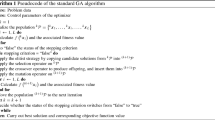Abstract
In this article, a new two-stage hybrid optimization method based on the Particle Swarm Optimization and the Big Bang-Big Crunch algorithm (BB-BC) is introduced for identification of highly non-linear systems. In this hybrid algorithm, the term of the center of mass from the BB-BC algorithm is incorporated into the standard particle swarm optimizer to markedly improve its searching abilities. In order to investigate the effectiveness of the newly formed optimization algorithm in identification of non-linear and hysteretic systems, it is utilized to optimally find the Bouc-Wen model’s parameters for a sample MR damper in which the damper’s force is related to its piston’s motion through a non-linear differential equation. The obtained results indicate that the proposed optimization method is highly robust and accurate and can be utilized successfully in such intricate non-linear identification problems.
Similar content being viewed by others
References
Atashpaz-Gargari, E. and Lucas, C. (2007). “Imperialist competitive algorithm: An algorithm for optimization inspired by imperialistic competition.” IEEE Congress on Evolutionary Computation, Singapore, pp. 4661–4667.
Bouc, R. (1967). “Forced vibrations of mechanical systems with hysteresis.” Proceeding of the 4th Conference on Nonlinear Oscillations, Prague, Czechoslovakia.
Charalampakis, A. E. and Dimou, C. K. (2010). “Identification of Bouc-Wen hysteretic systems using particle swarm optimization.” Computers and Structures, Vol. 88, Nos. 21–22, pp. 1197–1205.
De Jong, K. (1975). Analysis of the behavior of a class of genetic adaptive systems, PhD Thesis, University of Michigan, Ann Arbor, MI, USA.
Dorigo, M., Maniezzo, V., and Colorni, A. (1996). “The ant system: Optimization by a colony of cooperating agents.” IEEE Transactions on Systems, Man and Cybernetics, Vol. 26, No. 1, pp. 29–41.
Eberhart, R. C. and Kennedy, J. (1995). “A new optimizer using particle swarm theory.” Proceedings of the Sixth International Symposium on Micro Machine and Human Science, Nagoya, Japan.
Erol, O. K. and Eksin, I. (2006). “New optimization method: Big Bang-Big Crunch.” Advances in Engineering Software, Vol. 37, No. 2, pp. 106–111.
Farahmand Azar, B., Mohajer Rahbari, N., and Talatahari, S. (2011). “Seismic mitigation of tall buildings using magneto-rheological dampers.” Asian Journal of Civil Engineering, Vol. 12, No. 5, pp. 637–649.
Fogel, L. J., Owens, A. J. and Walsh, M. J. A. (1996). Artificial intelligence through simulated evolution, Wiley, Chichester, WS, UK.
Foliente, G. C. (1995). “Hysteresis modelling of wood joints and structural systems.” Journal of Structural Engineering, ASCE, Vol. 121, No. 6, pp. 1013–1022.
Gandomi, A. H. and Alavi A. H. (2012). “Krill herd: A new bio-inspired optimization algorithm.” Communications in Nonlinear Science and Numerical Simulation, DOI: 10.1016/j.cnsns.2012.05.010
Gandomi, A. H., Yang, X. S., and Alavi, A. H. (2011). “Mixed variable structural optimization using firefly algorithm.” Computers and Structures, Vol. 89, Nos. 23–24, pp. 2325–2336.
Gandomi, A. H., Yang, X. S., and Alavi, A. H. (2012). “Cuckoo search algorithm: A metaheuristic approach to solve structural optimization problems.” Engineering with Computers, DOI: 10.1007/s00366-011-0241-y
Glover, F. (1977). “Heuristic for integer programming using surrogate constraints.” Decision Sciences, Vol. 8, No. 1, pp. 156–166.
Goldberg, D. E. (1989). Genetic algorithms in search optimization and machine learning, Addison-Wesley, Boston.
Holland, J. H. (1975). Adaptation in natural and artificial systems, University of Michigan Press, Ann Arbor.
Kaveh, A., Farahmand Azar, B., and Talatahari, S. (2008). “Ant colony optimization for design of space trusses.” International Journal of Space Structures, Vol. 23, No. 3, pp. 167–181.
Kaveh, A. and Talatahari, S. (2009a). “Size optimization of space trusses using Big Bang-Big Crunch algorithm.” Computers and Structures, Vol. 87, Nos. 17–18, pp. 1129–1140.
Kaveh, A. and Talatahari, S. (2009b). “Particle swarm optimizer, ant colony strategy and harmony search scheme hybridized for optimization of truss structures.” Computers and Structures, Vol. 87, Nos. 5–6, pp. 267–83.
Kaveh, A. and Talatahari, S. (2010). “A novel heuristic optimization method: Charged system search.” Acta Mechanica, Vol. 213, Nos. 3–4, pp. 267–289.
Kaveh, A. and Talatahari, S. (2012). “Charged system search for optimal design of frame structures.” Applied Soft Computing, Vol. 12, No. 1, pp. 382–393.
Kirkpatrick, S., Gelatt, C., and Vecchi, M. (1983). “Optimization by simulated annealing.” Science, Vol. 220, No. 4598, pp. 671–680.
Koza, J. R. (1990). Genetic programming: A paradigm for genetically breeding populations of computer programs to solve problems, Report No. STAN-CS-90-1314, Stanford University, Stanford, CA.
Kunnath, S. K. (1997). “Parameter identification for degrading and pinched hysteretic structural concrete systems.” Engineering Structures, Vol. 19, No. 3, pp. 224–232.
Lin, S. S., Liao, J. C., Liang, T. T. and Juang, C. H. (2002). “Use of bouc-wen model for seismic analysis of concrete piles.” Proceedings of the International Deep Foundations Congress, Orlando, Florida, USA, pp. 372–384.
Mohajer Rahbari, N., Farahmand Azar, B., Talatahari, S., and Safari, H. (2012). “Semi-active direct control method for seismic alleviation of structures using MR dampers.” Structural Control and Health Monitoring, in press, DOI: 10.1002/stc.1515.
Ni, Y. Q., Ko, J. M., and Wong, C. W. (1998). “Identification of nonlinear hysteretic isolators from periodic vibration tests.” Journal of Sound and Vibration, Vol. 217, No. 4, pp. 737–756.
Spencer, B. F. Jr., Dyke, S. J., Sain, M. K. and Carlson, D. (1997). “Phenomenological model of a magnetorheological damper.” Journal of Engineering Mechanics, ASCE, Vol. 123, No. 3, pp. 230–238.
Wen, Y. K. (1976). “Method for random vibration of hysteretic systems.” Journal of Engineering Mechanics, ASCE, Vol. 102, No. 2, pp. 249–263.
Yang, X. S. and Gandomi, A. H. (2012). “Bat algorithm: A novel approach for global engineering optimization.” Engineering Computation, Vol. 29, No. 5, pp. 464–483.
Zhu, X. and Lu, X. (2011). “Parametric identification of bouc-wen model and its application in mild steel damper modeling.” The Proceedings of the Twelfth East Asia-Pacific Conference on Structural Engineering and Construction-EASEC12, Vol. 14, pp. 318–324.
Author information
Authors and Affiliations
Corresponding author
Rights and permissions
About this article
Cite this article
Talatahari, S., Rahbari, N.M. & Kaveh, A. A new hybrid optimization algorithm for recognition of hysteretic non-linear systems. KSCE J Civ Eng 17, 1099–1108 (2013). https://doi.org/10.1007/s12205-013-0341-x
Received:
Revised:
Accepted:
Published:
Issue Date:
DOI: https://doi.org/10.1007/s12205-013-0341-x




